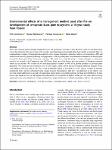Item Infomation
Full metadata record
| DC Field | Value | Language |
|---|---|---|
| dc.contributor.author | Sewerniak, Piotr | - |
| dc.contributor.author | Markiewicz, Maciej | - |
| dc.contributor.author | Tarnawska, Patrycja | - |
| dc.date.accessioned | 2023-10-04T07:50:40Z | - |
| dc.date.available | 2023-10-04T07:50:40Z | - |
| dc.date.issued | 2023 | - |
| dc.identifier.uri | https://link.springer.com/article/10.1007/s00267-023-01843-8 | - |
| dc.identifier.uri | https://dlib.phenikaa-uni.edu.vn/handle/PNK/9452 | - |
| dc.description | Cc-BY | vi |
| dc.description.abstract | Due to the ongoing climate changes, temperate forests are increasingly exposed to fires. However, until now the functioning of post-fire temperate forest ecosystems with regard to used forest management method has been weakly recognized. Here, we examined three variants of forest restoration after fire (two variants of natural regeneration with no soil preparation—NR, and artificial restoration by planting following soil preparation—AR) regarding their environmental consequences in development of post-fire Scots pine (Pinus sylvestris) ecosystem. The study was conducted using a 15-year timespan in a long-term research site located in the Cierpiszewo area (N Poland) being one of the biggest post-fire grounds in European temperate forests in last decades. We focused on soil and microclimatic variables as well as on growth dynamics of post-fire pines generation. We found that the restoration rates of soil organic matter, carbon and most studied nutritional elements stocks were higher in NR plots than in AR. | vi |
| dc.language.iso | en | vi |
| dc.publisher | Springer | vi |
| dc.subject | soil preparation—NR | vi |
| dc.subject | Scots pine ecosystem | vi |
| dc.title | Environmental effects of a management method used after fire on development of temperate Scots pine ecosystem: a 15-year study from Poland | vi |
| dc.type | Book | vi |
| Appears in Collections | ||
| OER - Khoa học môi trường | ||
Files in This Item:

